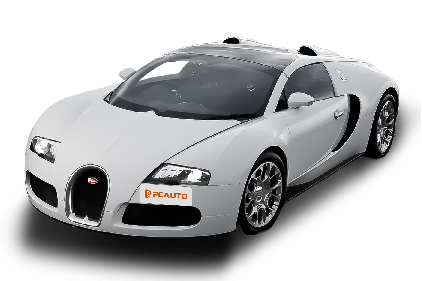Q
How many Bugatti Veyron are there in the world?
The Bugatti Veyron is a globally limited-production supercar. According to official data, from 2005 to 2015, including the regular version, the Grand Sport convertible version, the Super Sport high-performance version, and specially customized versions, a total of about 450 units were produced. Among them, the Super Sport version once set a world record for production cars with a top speed of 431 kilometers per hour, demonstrating Bugatti's ultimate pursuit of engineering and performance.
For car enthusiasts in Malaysia, although the Veyron is extremely rare locally, the Bugatti brand has gradually expanded its influence in the Southeast Asian market through official channels in recent years. For example, it has set up a showroom in Singapore. Maybe there will be more opportunities to see Bugatti models in Malaysia in the future.
As a milestone in Bugatti's modern revival, the Veyron is not only equipped with an 8.0-liter quad-turbocharged W16 engine. Its unique aerodynamic design and luxurious handcrafting also make it a rarity in the eyes of collectors. Subsequent models such as the Chiron and Divo have also carried on the technical essence of the Veyron, further consolidating Bugatti's top position in the supercar field.
Special Disclaimer: This content is published by users and does not represent the views or position of PCauto.
Related Q&A
Q
How long does it take to empty the tank on a Bugatti Veyron?
As a high - performance supercar, the Bugatti Veyron has a fuel tank capacity of approximately 100 liters. It has extremely high fuel consumption when driven at top speed. According to official data, when traveling at a top speed of 407 kilometers per hour, the fuel tank will run out in about 12 minutes. In daily driving conditions, the fuel consumption will be relatively lower, and the specific time depends on the driving style and road conditions.
For car enthusiasts in Malaysia, it should be noted that this kind of supercar is not designed to save fuel but to pursue ultimate performance. Therefore, in the local hot climate and congested traffic conditions, the actual fuel consumption may be even higher.
The Veyron is equipped with an 8.0 - liter quad - turbocharged W16 engine that can output over 1000 horsepower. This kind of power configuration brings an amazing acceleration experience but also means higher fuel consumption.
It is recommended that Malaysian owners, when using this kind of supercar, not only pay attention to fuel economy but also focus on regular maintenance. In particular, they should check the cooling system and lubrication system under high - temperature conditions to ensure that the vehicle is always in the best condition.
Q
Is the Bugatti Veyron faster than the Bugatti Chiron?
Both the Bugatti Veyron and the Bugatti Chiron are legendary models in the super - car world, but the Chiron truly outperforms the Veyron in terms of performance. When the Veyron was launched in 2005, it shocked the world with a top speed of 431 km/h. As its successor, the Chiron, after its release in 2016, further increased the top speed to 420 km/h (the electronically limited version). However, the unrestricted Chiron Super Sport 300+ set a production - car top - speed record of 490.48 km/h in 2019, far exceeding that of the Veyron.
Both cars are equipped with an 8.0 - liter quad - turbocharged W16 engine. Nevertheless, the Chiron's engine has been optimized, with the maximum horsepower increasing from 1001 hp of the Veyron to 1500 hp (in the Chiron Super Sport version). At the same time, the aerodynamics and chassis technology have been improved, resulting in better acceleration and handling.
For car enthusiasts in Malaysia, although these two models are rare locally, their engineering represents the pinnacle of the automotive industry and showcases Bugatti's pursuit of ultimate performance. It's worth noting that the performance of a super - car depends not only on its top speed but also on acceleration, cornering performance, and daily driving experience. The Chiron has been comprehensively upgraded in these aspects, making it more suitable for the needs of modern super - car users.
Q
How long do Bugatti Veyron tires last at top speed?
The tire life of the Bugatti Veyron at top speed is approximately 15 minutes. This is because when the vehicle is traveling at a maximum speed exceeding 400 km/h, the tires are subjected to extreme centrifugal forces and high temperatures, causing the rubber to wear out rapidly. Although the Michelin PAX tires specially designed for the Veyron use high - strength materials and a special structure to handle extreme conditions, rapid wear at top speed is still unavoidable. Therefore, Bugatti officially advises owners to avoid maintaining top - speed driving for long periods to extend tire life and ensure safety.
For owners in Malaysia, although local road conditions cannot meet the Veyron's top - speed requirements, understanding this helps in better maintaining the supercar's tires. During daily driving, attention should be paid to tire maintenance. For example, regularly check tire pressure and wear, and avoid aggressive driving. Additionally, Malaysia's hot climate may also accelerate tire aging, so it is recommended to park the vehicle in a shady place and use appropriate tire protectants.
Q
Why is the Bugatti Veyron so popular?
The reason why the Bugatti Veyron is so popular is mainly due to its status as the benchmark for supercars in the early 21st century. Its 8.0-liter W16 quad-turbocharged engine can output 1,001 horsepower, and its top speed exceeds 407 km/h, making it the fastest production car in the world at that time. This extreme performance has attracted countless car enthusiasts. For Malaysian car enthusiasts, the Veyron is not just a speed machine but also a symbol of engineering art. Its carbon fiber body, active aerodynamic design, and precise hand - made manufacturing process showcase the pinnacle of the automotive industry. The success of the Veyron has also promoted the development of subsequent models such as the Chiron, further consolidating Bugatti's position in the super - car field. It is worth mentioning that although the hot and rainy climate in Malaysia poses challenges to the maintenance of high - performance cars, top - notch supercars like the Veyron are still regarded as treasures by local collectors. Whenever it occasionally makes an appearance at high - end car gatherings in Kuala Lumpur or Penang, it always causes a sensation. Its rarity (only 450 units were produced globally) and legendary status also make it an important symbol in automotive culture.
Q
How much is a Bugatti Veyron full tank?
The Bugatti Veyron has a fuel tank capacity of 100 liters. Based on the current price of RON 97 gasoline in Malaysia (around 3.50 ringgit per liter), it would cost approximately 350 ringgit to fill up the tank. However, as a top - tier supercar, the Veyron usually recommends using higher - grade fuel to ensure its performance, so the actual cost might be slightly higher. The car is equipped with an 8.0 - liter W16 quad - turbocharged engine. While it offers astonishing power, it also has relatively high fuel consumption. In urban driving, the fuel consumption per 100 kilometers could exceed 30 liters, so frequent refueling is the norm.
For car enthusiasts in Malaysia, apart from the fuel cost, they also need to consider the maintenance and insurance costs of such supercars, which are significantly higher than those of ordinary vehicles. Additionally, the hot and humid climate in Malaysia poses a challenge to the cooling system of high - performance engines, making regular maintenance especially crucial.
As a limited - production top - tier supercar, the Bugatti Veyron is rarely seen on Malaysian roads. Its rarity also makes it highly sought after in the collector's market.
Q
What car replaced the Bugatti Veyron?
The successor to the Bugatti Veyron is the Bugatti Chiron. This super - car was officially launched in 2016, inheriting the legendary status of the Veyron and achieving a full - scale upgrade in performance and technology. The Chiron is equipped with an 8.0 - liter quad - turbocharged W16 engine with a maximum power of 1500 horsepower. Its top speed is electronically limited to 420 km/h, and it can accelerate from 0 to 100 km/h in just 2.5 seconds, demonstrating Bugatti's top - notch technological strength in the super - car field. For car enthusiasts in Malaysia, although this kind of super - car is quite rare locally, they still have a chance to appreciate it up close through official dealers or international auto shows. The Chiron not only continues the extreme performance of the Veyron but also incorporates more modern technology and luxury design, such as more advanced aerodynamic kits and customized services, further consolidating Bugatti's leading position in the super - car market. It's worth mentioning that Bugatti has also launched several special - edition models based on the Chiron, such as the Chiron Super Sport 300+ and the Chiron Pur Sport, to meet the needs of different collectors.
Q
How much is a Bugatti Veyron oil change?
The cost of changing the oil for a Bugatti Veyron varies depending on the region and the service center. However, based on global data, the cost of a single oil change usually ranges from RM 20,000 to RM 25,000. This is mainly due to the fact that its 8.0-liter W16 engine requires high-performance oil and a complex maintenance process. Additionally, the Veyron has a large oil capacity (around 15 liters) and needs high-spec synthetic oil specifically designed for supercars, which further drives up the cost.
For Malaysian owners, since there is no official Bugatti service center in the country, they may need to transport their vehicles to neighboring countries such as Singapore or Thailand for maintenance. This will incur additional transportation and tariff costs. It's worth noting that the regular maintenance of a supercar doesn't just involve changing the oil. It also includes checking key components such as the turbocharging system, suspension, and brakes to ensure the vehicle is always in top condition. Therefore, it is recommended that owners set aside a sufficient budget to cover the comprehensive maintenance expenses.
If you're thinking about owning a top - tier supercar like the Veyron in the long term, it's very important to understand its maintenance cycle (usually every 10,000 kilometers or once a year) and the overall maintenance cost. This way, you can avoid affecting the vehicle's performance and resale value due to negligence.
Q
Is the Bugatti Veyron a luxury car?
The Bugatti Veyron is truly a luxury car. It is not only renowned for its outstanding performance but also has become an iconic product in the automotive world due to its exquisite craftsmanship and luxurious design. As a supercar, the Veyron is equipped with an 8.0 - liter quad - turbocharged W16 engine and can reach a top speed of 407 kilometers per hour. This kind of performance has earned it a special place in the hearts of car enthusiasts in Malaysia and around the world. Although its price is extremely high, it also reflects its rarity and top - notch manufacturing standards. In Malaysia, due to taxes and import restrictions, the Veyron is even rarer. Therefore, owning it is not only a symbol of wealth but also a pursuit of the ultimate in automotive craftsmanship. It's worth mentioning that the interior of the Veyron uses top - grade materials such as genuine leather and aluminum alloy. Every detail has been meticulously crafted to ensure that drivers and passengers enjoy an unparalleled experience of comfort and luxury. For Malaysian car fans, the Veyron is not just a car; it is a combination of engineering and art, representing the pinnacle of the automotive industry.
Q
Why was the Bugatti Veyron discontinued?
The discontinuation of the Bugatti Veyron is mainly because its product life cycle is nearing the end. Meanwhile, Bugatti aims to concentrate its resources on the R & D of new - generation supercars, such as the subsequently launched Chiron. This car has seen significant improvements in performance and technology, and the Veyron has fulfilled its mission as the brand's flagship.
Since its launch in 2005, the Veyron has become a milestone in the automotive industry with its astonishing 1001 horsepower and a top speed of over 400 km/h. However, with the development of technology and the increasingly strict environmental regulations, Bugatti needs to introduce more advanced and efficient models to meet market demands.
For Malaysian car enthusiasts, although the Veyron is extremely rare in the local area, it represents the pinnacle of super - car technology. Subsequent models like the Chiron continue this legend, and Bugatti also consolidates its leading position in the super - car field by constantly pushing the engineering limits.
The discontinuation of the Veyron is not due to problems with the brand or the model. Instead, it is a common product iteration strategy in the automotive industry to ensure the brand's continuous innovation and competitiveness.
Q
What is the cheapest Bugatti Veyron sold for?
Currently, the cheapest known second - hand transaction price of the Bugatti Veyron is around $1.5 million to $2 million (equivalent to about RM7 million to RM9 million). The specific price depends on the vehicle's condition, mileage, and modification status. For example, in 2018, an early - model Veyron with high mileage in the United States was sold for $1.5 million.
As a legendary supercar, the Veyron is extremely rare in Malaysia. This is mainly because of the high import duties (which may exceed 300% depending on the engine displacement), resulting in the on - the - road price far exceeding the international market price. For instance, the original price of a new Veyron is about $2.5 million (the price including taxes may reach over RM30 million).
The Veyron is equipped with an 8.0 - liter W16 quad - turbo engine and can reach a top speed of 407 km/h. When it was launched in 2005, it was the world's fastest production car. Due to its complex craftsmanship, only 450 units were produced (including derivative models such as the Super Sport), which makes the supply of second - hand cars scarce.
It's worth noting that when buying such supercars in Southeast Asia, one also needs to consider the potential impact of the hot and humid climate on carbon fiber components and electronic systems. It is recommended to conduct a complete inspection through a professional institution. Meanwhile, Malaysian car owners usually store these types of vehicles in a constant - temperature garage to extend their service life.
Popular Cars
Model Year
Car Compare
Car Photo
Latest Q&A
Q
What is the most powerful 1.6 litre engine?
One of the most potent 1.6-liter engines on the market is the turbocharged four-cylinder you’ll find in certain high-performance models. Take the track-tuned variants, for example—they’re pushing over 300 horsepower. These engines typically pack direct injection, high-boost turbos, and lightweight materials to maximize performance without sacrificing fuel efficiency.
In more mainstream sporty models, 1.6T units can still deliver around 200 hp, with tech like variable valve timing and twin-scroll turbos improving low-end torque. That said, high-output small-displacement engines demand robust cooling and durability, so stick to regular maintenance and use the right spec oil.
If you’re eyeing mods, a 1.6T with a cast-iron block usually handles big power upgrades better than aluminum-block engines—just watch out for local emissions and noise regulations.
Q
What is 454 in liters?
The conversion of 454 cubic inches to liters is approximately 7.4 liters, which is a commonly used volumetric unit to describe large displacement engines, especially in American muscle cars or classic old cars. For example, some V8 engines in Chevrolet use this displacement. This type of large displacement engine typically provides ample low-speed torque, making it suitable for car owners who pursue acceleration performance and rich sound waves. However, the fuel consumption is relatively high, and the daily use cost will increase. With the popularization of turbocharging technology nowadays, small displacement engines can also achieve power output close to large displacement through turbocharging, while also having better fuel economy. This is also why large displacement naturally aspirated engines are gradually decreasing in the market. However, for enthusiasts who enjoy traditional American muscle cars or classic car modification culture, large displacement engines still have their unique charm, and it is difficult to completely replace both the sound wave and the linear feeling of power output.
Q
What is a 440 engine in liters?
The term "440 engine" typically refers to Chrysler's legendary 7.2-liter V8 powerhouse. This big-block mill dominated the muscle car and full-size sedan scene during the 1960s and '70s, famous for its tire-shredding low-end torque and that signature rumbling exhaust note. For those keeping metric scorecards, 440 cubic inches translates to roughly 7.2 liters of displacement - pure American muscle at its finest. You'd find these beasts under the hood of icons like the Dodge Charger and Plymouth Road Runner.
While modern engines chase fuel efficiency, there's still a cult following for these old-school naturally aspirated monsters. They deliver that addictive linear powerband and mechanical symphony no turbocharged four-banger can match. But here's the kicker - displacement isn't everything. Factors like bore/stroke ratio, compression, and airflow tuning mean today's tiny turbo engines can sometimes punch way above their weight class. Still, nothing replicates the visceral thrill of twisting that 440's throttle and feeling seven liters of Detroit iron come alive.
Q
What does 4.5 liter engine mean?
A 4.5-liter engine refers to a total displacement of 4.5 liters, meaning all its cylinders combine for a total working volume of 4,500 cubic centimeters. Generally, a larger displacement translates to stronger power output—more air and fuel can be drawn in each combustion cycle, generating greater horsepower and torque.
You’ll typically find these big-displacement engines in high-performance cars, luxury vehicles, or full-size SUVs, where they deliver ample power and smoother driving dynamics. The trade-off? Higher fuel consumption, which can mean steeper running costs, especially in regions with expensive gas. Maintenance also tends to be pricier, since they require more oil and more complex servicing.
With tightening emissions regulations, many automakers are shifting toward smaller turbocharged or hybrid setups that offer similar power with better efficiency. But for driving purists, nothing quite matches the linear power delivery and throaty roar of a big, naturally aspirated engine. It’s an experience that’s hard to replicate.
Q
What is a 1.6 L I4?
The 1.6L I4 refers to a 1.6-liter inline-four engine, where "L" stands for liters (a unit of volume) and "I4" indicates an inline-four layout—one of the most common engine configurations in family cars today. It strikes a solid balance between power output, fuel efficiency, and production costs, making it ideal for daily commuting and family use. You’ll find this setup everywhere, from Japanese and German models to domestic brands.
A naturally aspirated 1.6L typically delivers around 120 to 150 horsepower, while turbocharged versions (like the 1.6T) push performance further. The inline-four design is compact, easy to maintain, and smooth-running, which works great for front-wheel-drive layouts. For buyers on a budget who still want reliable power, the 1.6L I4 is a no-nonsense pick. Plus, it’s got decent tuning potential—enthusiasts often tweak the intake/exhaust or remap the ECU for extra kick.
View More















Pros
Cons